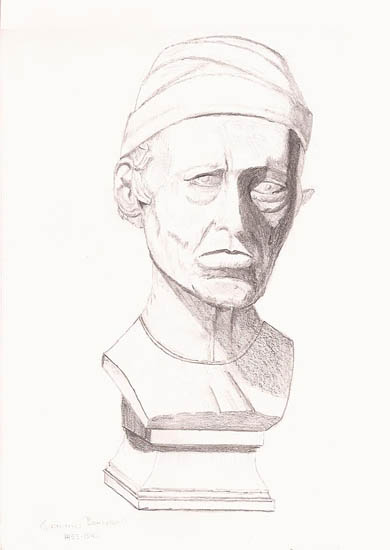Long before I decided to learn to draw I was a fountain pen guy. I’ve always loved the feel of a nib running across paper. So when I started trying to learn to draw, I used a fountain pen. It’s still my tool of choice some two years later.
Some would argue this is a good thing as it forced me to look a lot and draw a little as erasers weren’t part of the process. I think this is true and that it has helped me acquire a rudimentary ‘artist’s eye’, though that eye is still ill-developed.
But at the same time, I missed out on the more typical starting point for someone learning to draw – graphite or charcoal. The pencil remains a very popular drawing tool and I’m completely ignorant of its uses. I do carry a mechanical pencil but it’s full of 3H or 4H lead and I use it just to draw a few guidelines to block in a drawing and I quickly switch to pen for the rest. So I’ve decided that I need to learn a bit about 2B, HB, and 4H pencils and how to rub them around to create value. I also need to learn what you do with a kneaded eraser. It’s a very clumsy process. But I’m trying, mostly with little scribbles and doodles.
Monday I went with Yvan to the nearly hidden ‘museum’ at the university. It holds the contents of the long defunct natural history museum, the university insect collection, and roughly 300 plaster casts. These were given to the university sometime in the 19th Century, when art departments thought it wise for their students to learn to draw. When they decided that you didn’t need to draw to be an artist if you were going to paint with a roller, spatula or by throwing paint at the canvas, all the casts were, well, cast off. Only the insight and diligence of Madame Wagner, the curator of the ‘museum’, saved them from becoming so much broken plaster.
And so little old me has access to some 300 plaster casts of hands, feet, ears, noses, busts of famous people, and many, many full-size statues. It makes even this street sketcher say KEWL! I chose a poet named Benivieni as my first subject. It wasn’t due to any affinity for him as I have no idea who he is but I liked his hat (grin).
Here’s my first attempt at doing a bust with a pencil. It’s not perfect but it does, sorta-kinda, look like him so I was both surprised and happy. I do have to work more on that ‘artist’s eye’ as seeing the half-tones is a challenge, but I think I’ll go back next week. Those art students don’t know what they’re missing.


Are you sure you didn’t stay up all night practicing?
I was going to say “as a first attempt it’s pretty darn good”
But decided that it is “pretty darn good” no matter how long you have been using a pencil!
Thanks, Alan. I think it’s the case with this art stuff that if you accumulate enough baby steps and you can actually cover some ground 🙂
Cheers — Larry
Very, very nice Larry. Some of those lines are amazing! (And actually to answer your question, I use Tombow Monos – very smooth, but they yield more of a gray than black, even with the 5B – and Mitsubishi Hi Unis if I want blacks (2B and 4B). Both smear, but a lot less than charcoal. And I sometimes grip the pencil underhand, especially at a table easel). Well done. Thanks for sharing.
Jeff
Don’t know about amazing lines, Jeff but I do know about that smearing stuff 🙂 My real goal here is to learn how to see half-tones better. I’m happy sticking with the harder end of the pencil scale at this point. As for easels, I have tried them and I guess I’m a street sketcher at heart as I find the whole easel thing to just get in the way of enjoying myself.
Cheers — Larry
You’ll be happy to know that students of the Gage Academy in Seattle still learn by drawing busts and other plaster casts. Related to that, I found all three of the Aristides books at the library this week. Thanks again for the tip.
Hee…hee. Of course they do, Tina. In the introduction to Classical Drawing Atelier, Aristides talks about how the art system is ‘broken’ and that traditional techniques are no longer being taught. This, she says, is the reason for the ‘atelier movement’ on which the Gage is based. She describes what happened to in the fine arts school here, though she’s speaking more generally. As with many things, the pendulum swung away from learning traditional art/techniques. There is some evidence that it may be moving back and certainly the ateliers around the world have had some role in that. For what it’s worth, our art store lists “fine art supplies” and “graphic design” supplies separately. ALL of the drawing supplies are listed under graphic design.
Cheers — Larry